Abstract
Colonic crypt cell proliferation is used as an indicator of risk of colorectal carcinoma. Subjects with adenomatous polyps and cancer have an increased cell proliferation and a shift of the proliferative zone towards the apex of the crypt. Epidemiological and in vitro studies have confirmed a link between vitamins A, E, C, beta-carotene, and colorectal cancer. In vitro bromodeoxyuridine immunohistochemical technique was used to assess the effect of daily oral supplementation with vitamin E (160 mg), vitamin C (750 mg), or beta-carotene (9 mg) on the colonic crypt cell proliferation in patients with adenomatous polyps (n = 40) compared with normal subjects with no colonic disease (n = 20). The patients were given supplementation for one month and colonic biopsy specimens were taken before and at the end of the trial. Patients with adenomatous polyps had a significantly higher mean labelling index per cent than controls (p < 0.001). Vitamin C or beta-carotene supplementation, however, significantly reduced the total proliferation (p < 0.005) whereas vitamin E supplementation had no effect on the colonic crypt cell proliferation. beta-carotene reduced cell proliferation at the base of the crypt only. Vitamin C reduced cell proliferation in all the crypt compartments from the apex to the base to those values seen in age and sex matched controls. These findings indicate that prolonged supplementation with vitamin C may reduce the recurrence of adenomatous polyps.
Full text
PDF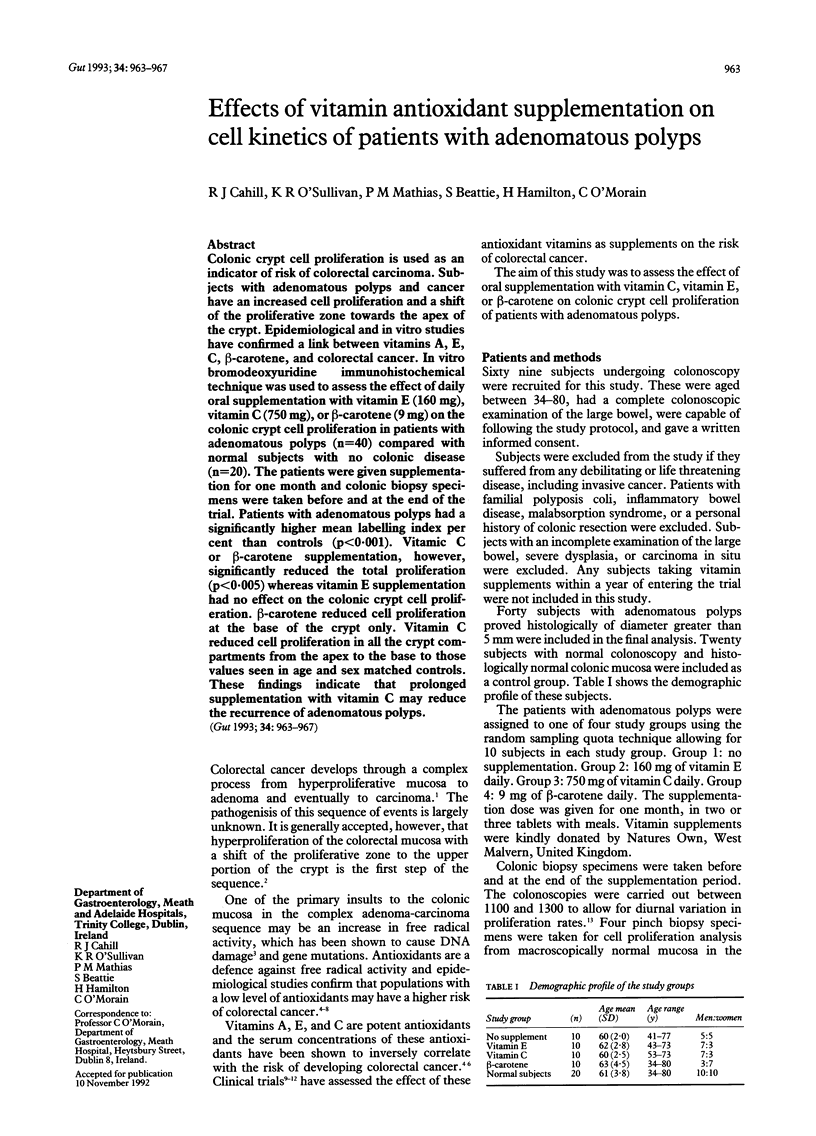
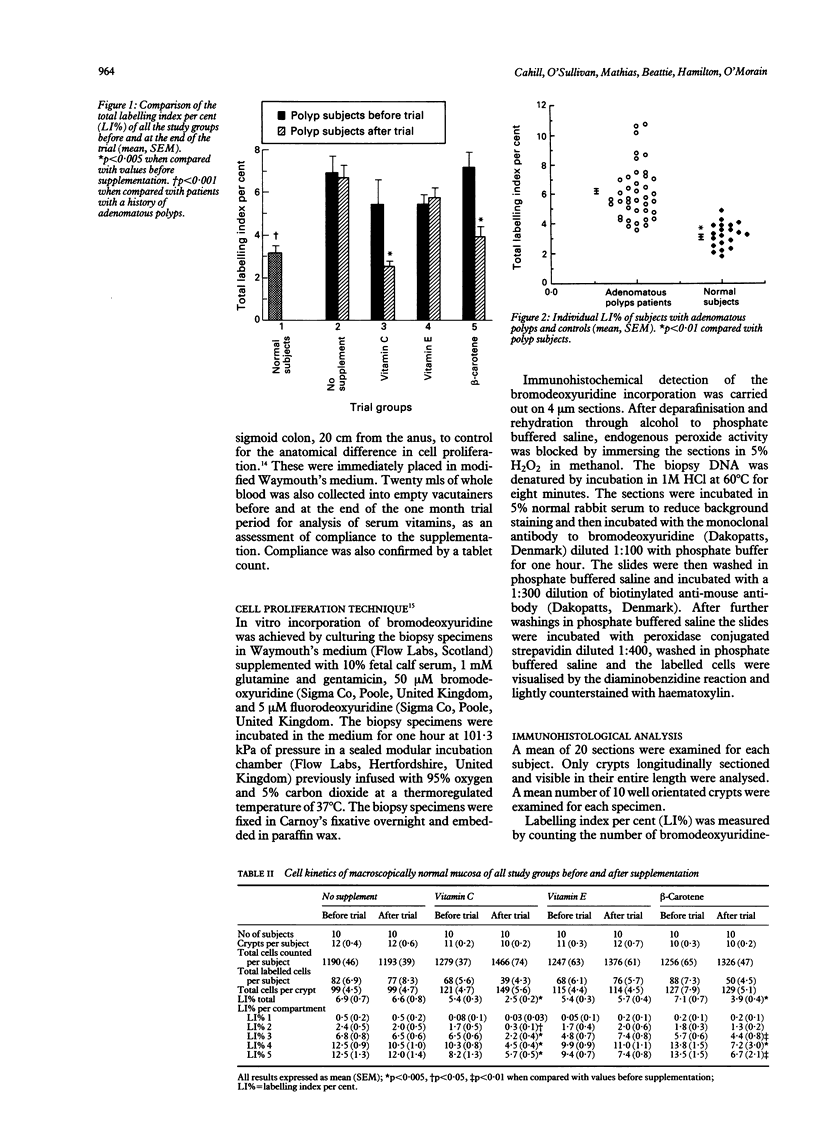
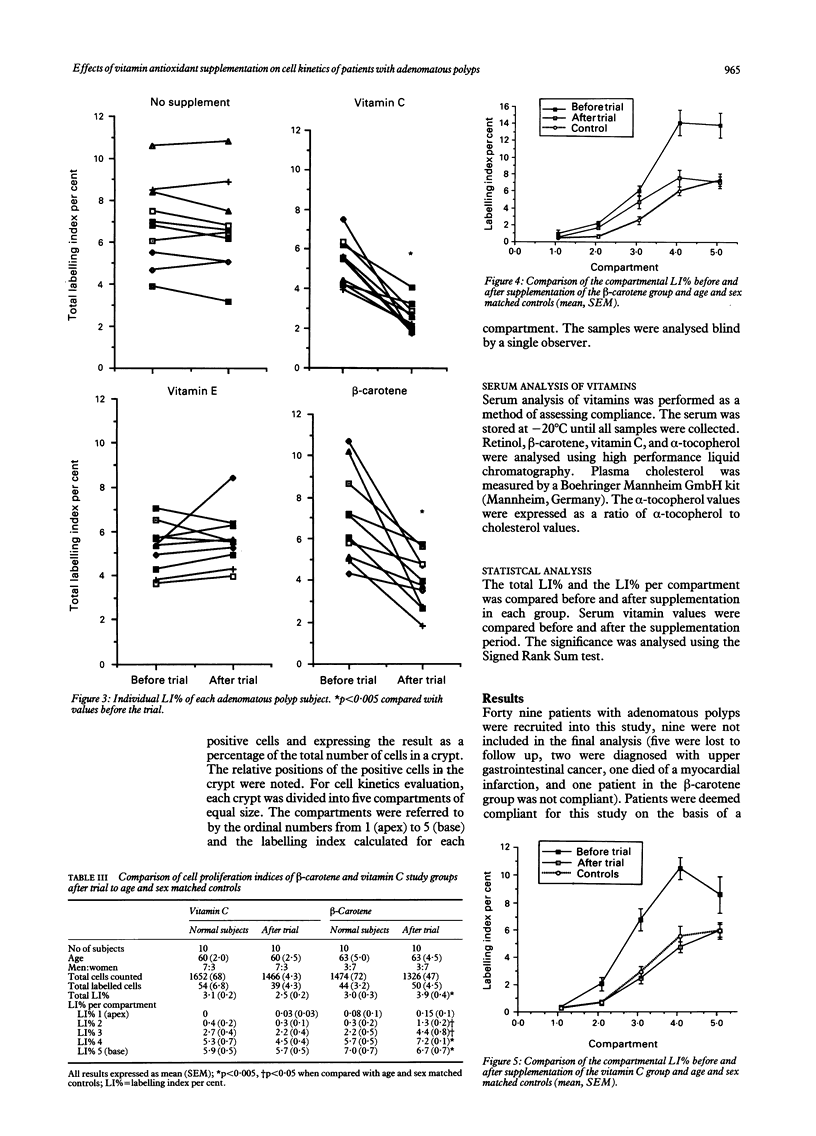
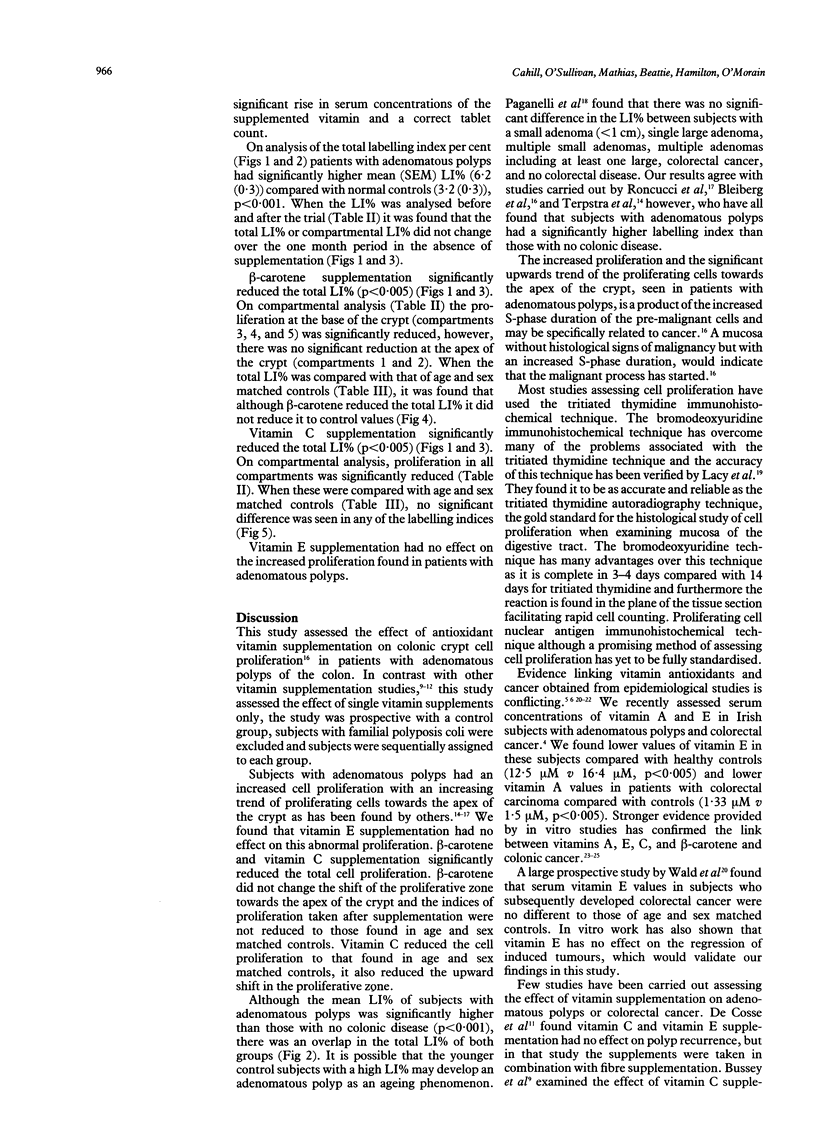
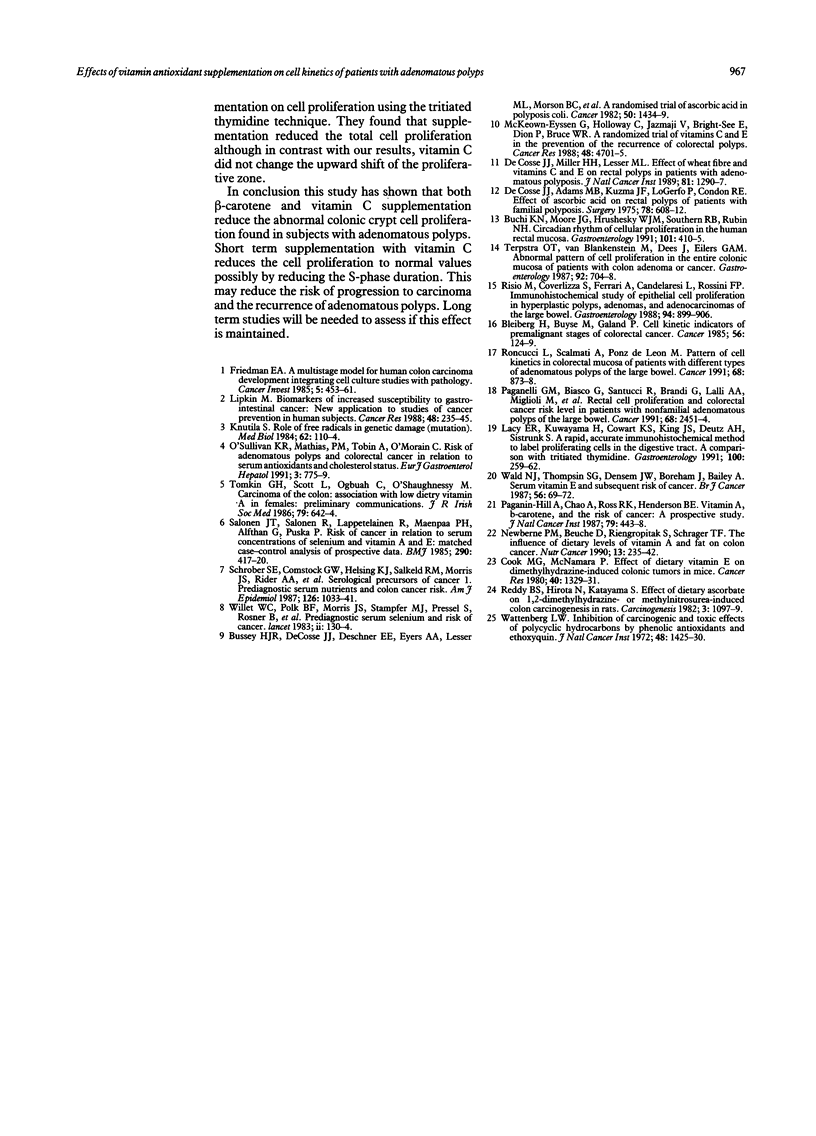
Selected References
These references are in PubMed. This may not be the complete list of references from this article.
- Bleiberg H., Buyse M., Galand P. Cell kinetic indicators of premalignant stages of colorectal cancer. Cancer. 1985 Jul 1;56(1):124–129. doi: 10.1002/1097-0142(19850701)56:1<124::aid-cncr2820560119>3.0.co;2-y. [DOI] [PubMed] [Google Scholar]
- Buchi K. N., Moore J. G., Hrushesky W. J., Sothern R. B., Rubin N. H. Circadian rhythm of cellular proliferation in the human rectal mucosa. Gastroenterology. 1991 Aug;101(2):410–415. doi: 10.1016/0016-5085(91)90019-h. [DOI] [PubMed] [Google Scholar]
- Bussey H. J., DeCosse J. J., Deschner E. E., Eyers A. A., Lesser M. L., Morson B. C., Ritchie S. M., Thomson J. P., Wadsworth J. A randomized trial of ascorbic acid in polyposis coli. Cancer. 1982 Oct 1;50(7):1434–1439. doi: 10.1002/1097-0142(19821001)50:7<1434::aid-cncr2820500733>3.0.co;2-f. [DOI] [PubMed] [Google Scholar]
- Cook M. G., McNamara P. Effect of dietary vitamin E on dimethylhydrazine-induced colonic tumors in mice. Cancer Res. 1980 Apr;40(4):1329–1331. [PubMed] [Google Scholar]
- DeCosse J. J., Adams M. B., Kuzma J. F., LoGerfo P., Condon R. E. Effect of ascorbic acid on rectal polyps of patients with familial polyposis. Surgery. 1975 Nov;78(5):608–612. [PubMed] [Google Scholar]
- DeCosse J. J., Miller H. H., Lesser M. L. Effect of wheat fiber and vitamins C and E on rectal polyps in patients with familial adenomatous polyposis. J Natl Cancer Inst. 1989 Sep 6;81(17):1290–1297. doi: 10.1093/jnci/81.17.1290. [DOI] [PubMed] [Google Scholar]
- Friedman E. A. A multistage model for human colon carcinoma development integrating cell culture studies with pathology. Cancer Invest. 1985;3(5):453–461. doi: 10.3109/07357908509039806. [DOI] [PubMed] [Google Scholar]
- Knuutila S. Role of free radicals in genetic damage (mutation). Med Biol. 1984;62(2):110–114. [PubMed] [Google Scholar]
- Lacy E. R., Kuwayama H., Cowart K. S., King J. S., Deutz A. H., Sistrunk S. A rapid, accurate, immunohistochemical method to label proliferating cells in the digestive tract. A comparison with tritiated thymidine. Gastroenterology. 1991 Jan;100(1):259–262. doi: 10.1016/0016-5085(91)90610-w. [DOI] [PubMed] [Google Scholar]
- Lipkin M. Biomarkers of increased susceptibility to gastrointestinal cancer: new application to studies of cancer prevention in human subjects. Cancer Res. 1988 Jan 15;48(2):235–245. [PubMed] [Google Scholar]
- McKeown-Eyssen G., Holloway C., Jazmaji V., Bright-See E., Dion P., Bruce W. R. A randomized trial of vitamins C and E in the prevention of recurrence of colorectal polyps. Cancer Res. 1988 Aug 15;48(16):4701–4705. [PubMed] [Google Scholar]
- Newberne P. M., Bueche D., Riengropitak S., Schrager T. F. The influence of dietary levels of vitamin A and fat on colon cancer. Nutr Cancer. 1990;13(4):235–242. doi: 10.1080/01635589009514065. [DOI] [PubMed] [Google Scholar]
- Paganelli G. M., Biasco G., Santucci R., Brandi G., Lalli A. A., Miglioli M., Barbara L. Rectal cell proliferation and colorectal cancer risk level in patients with nonfamilial adenomatous polyps of the large bowel. Cancer. 1991 Dec 1;68(11):2451–2454. doi: 10.1002/1097-0142(19911201)68:11<2451::aid-cncr2820681121>3.0.co;2-4. [DOI] [PubMed] [Google Scholar]
- Paganini-Hill A., Chao A., Ross R. K., Henderson B. E. Vitamin A, beta-carotene, and the risk of cancer: a prospective study. J Natl Cancer Inst. 1987 Sep;79(3):443–448. [PubMed] [Google Scholar]
- Reddy B. S., Hirota N., Katayama S. Effect of dietary sodium ascorbate on 1,2-dimethylhydrazine- or methylnitrosourea-induced colon carcinogenesis in rats. Carcinogenesis. 1982;3(9):1097–1099. doi: 10.1093/carcin/3.9.1097. [DOI] [PubMed] [Google Scholar]
- Risio M., Coverlizza S., Ferrari A., Candelaresi G. L., Rossini F. P. Immunohistochemical study of epithelial cell proliferation in hyperplastic polyps, adenomas, and adenocarcinomas of the large bowel. Gastroenterology. 1988 Apr;94(4):899–906. doi: 10.1016/0016-5085(88)90545-8. [DOI] [PubMed] [Google Scholar]
- Roncucci L., Scalmati A., Ponz de Leon M. Pattern of cell kinetics in colorectal mucosa of patients with different types of adenomatous polyps of the large bowel. Cancer. 1991 Aug 15;68(4):873–878. doi: 10.1002/1097-0142(19910815)68:4<873::aid-cncr2820680433>3.0.co;2-p. [DOI] [PubMed] [Google Scholar]
- Salonen J. T., Salonen R., Lappeteläinen R., Mäenpä P. H., Alfthan G., Puska P. Risk of cancer in relation to serum concentrations of selenium and vitamins A and E: matched case-control analysis of prospective data. Br Med J (Clin Res Ed) 1985 Feb 9;290(6466):417–420. doi: 10.1136/bmj.290.6466.417. [DOI] [PMC free article] [PubMed] [Google Scholar]
- Schober S. E., Comstock G. W., Helsing K. J., Salkeld R. M., Morris J. S., Rider A. A., Brookmeyer R. Serologic precursors of cancer. I. Prediagnostic serum nutrients and colon cancer risk. Am J Epidemiol. 1987 Dec;126(6):1033–1041. doi: 10.1093/oxfordjournals.aje.a114742. [DOI] [PubMed] [Google Scholar]
- Terpstra O. T., van Blankenstein M., Dees J., Eilers G. A. Abnormal pattern of cell proliferation in the entire colonic mucosa of patients with colon adenoma or cancer. Gastroenterology. 1987 Mar;92(3):704–708. doi: 10.1016/0016-5085(87)90021-7. [DOI] [PubMed] [Google Scholar]
- Wald N. J., Thompson S. G., Densem J. W., Boreham J., Bailey A. Serum vitamin E and subsequent risk of cancer. Br J Cancer. 1987 Jul;56(1):69–72. doi: 10.1038/bjc.1987.156. [DOI] [PMC free article] [PubMed] [Google Scholar]
- Wattenberg L. W. Inhibition of carcinogenic and toxic effects of polycyclic hydrocarbons by phenolic antioxidants and ethoxyquin. J Natl Cancer Inst. 1972 May;48(5):1425–1430. [PubMed] [Google Scholar]
- Willett W. C., Polk B. F., Morris J. S., Stampfer M. J., Pressel S., Rosner B., Taylor J. O., Schneider K., Hames C. G. Prediagnostic serum selenium and risk of cancer. Lancet. 1983 Jul 16;2(8342):130–134. doi: 10.1016/s0140-6736(83)90116-2. [DOI] [PubMed] [Google Scholar]


